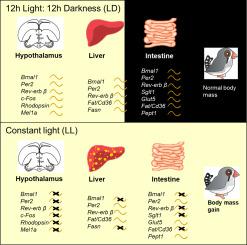Journal of Photochemistry and Photobiology B: Biology ( IF 3.9 ) Pub Date : 2020-08-14 , DOI: 10.1016/j.jphotobiol.2020.111995 Abhilash Prabhat 1 , Indu Malik 1 , Neelu Anand Jha 1 , Sanjay Kumar Bhardwaj 2 , Vinod Kumar 1

|
A most crucial feature of biological adaptation is the maintenance of a close temporal relationship of behaviour and physiology with prevailing 24-h light-dark environment, which is rapidly changing with increasing nighttime illumination. This study investigated developmental effects of the loss of night on circadian behaviour, metabolism and gene expressions in diurnal zebra finches born and raised under LL, with controls on 12L:12D. Birds under LD were entrained, and showed normal body mass and a significant 24-h rhythm in both activity-rest pattern and mRNA expression of candidate genes that we measured. But, under LL, birds gained weight and accumulated lipid in the liver. Intriguingly, at the end of the experiment, the majority (4/5th) of birds under LL were rhythmic in activity despite arrhythmic expression in the hypothalamus of c-Fos (neuronal activity), Rhodopsin and Mel1-a genes (light perception), and clock genes (Bmal1, Per2 and Rev-erb β). In peripheral tissues, LL induced variable clock gene expressions. Whereas 24-h mRNA rhythm was abolished for Bmal1 in both liver and gut, it persisted for Per2 and Rev-erb β in liver, and for Per2 in gut. Further, we found under LL, the loss of 24-h rhythm in hepatic expression of Fasn and Cd36/Fat (biosynthesis and its uptake), and gut expression of Sglt1, Glut5, Cd36 and Pept1 (nutrient absorption) genes. As compared to LD, baseline mRNA levels of Fasn and Cd36 genes were attenuated under LL. Among major transporter genes, Sglt1 (glucose) and Cd36 (fat) genes were arrhythmic, while Glut5 (glucose) and Pept1 (protein) genes were rhythmic but with phase differences under LL, compared to LD. These results demonstrate dissociation of circadian behaviour from clock gene rhythms, and provide molecular insights into possible mechanisms at different levels (behaviour and physiology) that diurnal animals might employ in order to adapt to an emerging overly illuminated-night urban environment.
中文翻译:

恒定光对斑马雀科动物昼夜节律行为和基因表达的发育影响:深入了解昼夜动物代谢适应非周期性环境的机制。
生物适应性的最关键特征是维持行为和生理与主要的24小时光暗环境之间的紧密时间关系,该环境随夜间照明的增加而迅速变化。这项研究调查了夜宵对在LL条件下出生和饲养的昼夜斑马雀的昼夜节律,代谢和基因表达的发育影响,并控制了12L:12D。LD之下的鸟被带走,并且在我们测定的候选基因的活动休息模式和mRNA表达上均显示正常体重和显着的24小时节律。但是,在低速状态下,鸟类体重增加并在肝脏中积累脂质。有趣的是,在实验结束时,尽管在下丘脑的下丘脑中出现了心律失常的表达,但在LL下的大多数鸟类(4/5)的活动都有节律性c-Fos(神经元活性),视紫红质和Mel1-a基因(光感知)和时钟基因(Bmal1,Per2和Rev-erbβ)。在周围组织中,LL诱导可变时钟基因表达。而24小时的mRNA的节奏被废除了BMAL1在肝脏和肠道,它持续了Per2基因和牧师-ERBβ在肝脏和Per2基因在肠道。此外,我们在LL下发现Fasn和Cd36 / Fat的肝表达(生物合成及其摄取)以及Sglt1,Glut5,Cd36和Pept1的肠道表达24小时节律丧失。(营养吸收)基因。与LD相比,LLs减弱了Fasn和Cd36基因的基线mRNA水平。与LD相比,在主要转运蛋白基因中,Sglt1(葡萄糖)和Cd36(脂肪)基因具有节律性,而Glut5(葡萄糖)和Pept1(蛋白质)基因具有节律性,但在LL下具有相差。这些结果证明了昼夜节律行为与时钟基因节律的分离,并提供了昼夜动物可能采用的不同水平(行为和生理学)可能机制的分子见解,以适应新兴的过度照亮的夜晚城市环境。











































 京公网安备 11010802027423号
京公网安备 11010802027423号